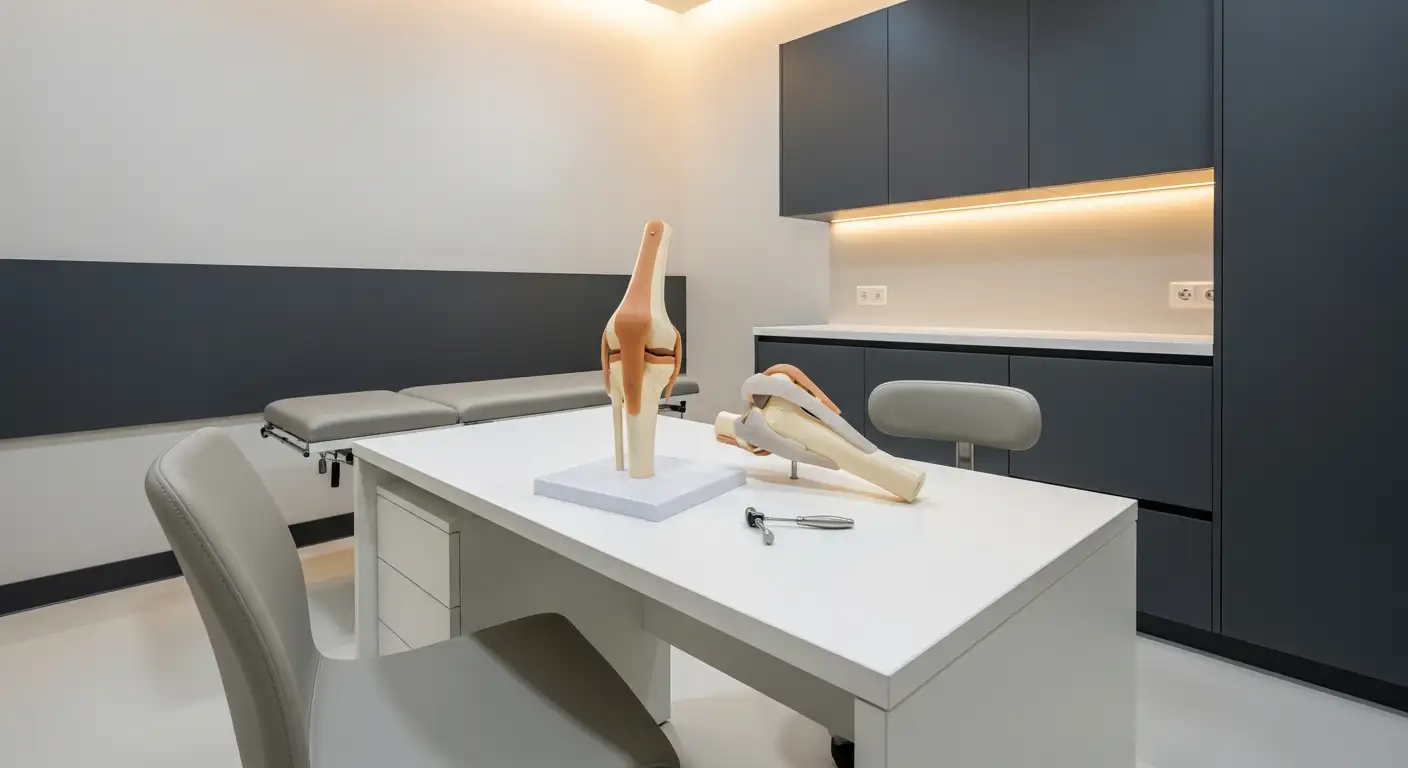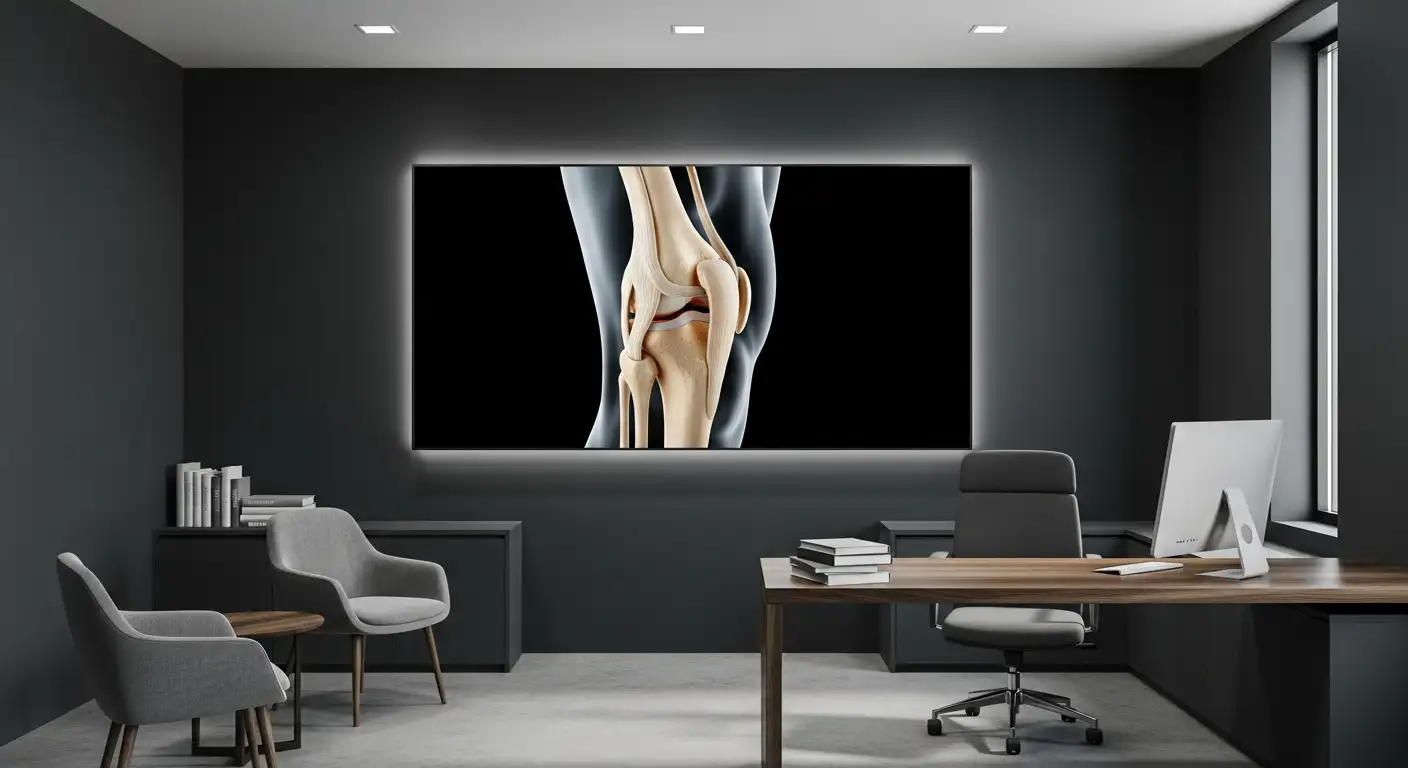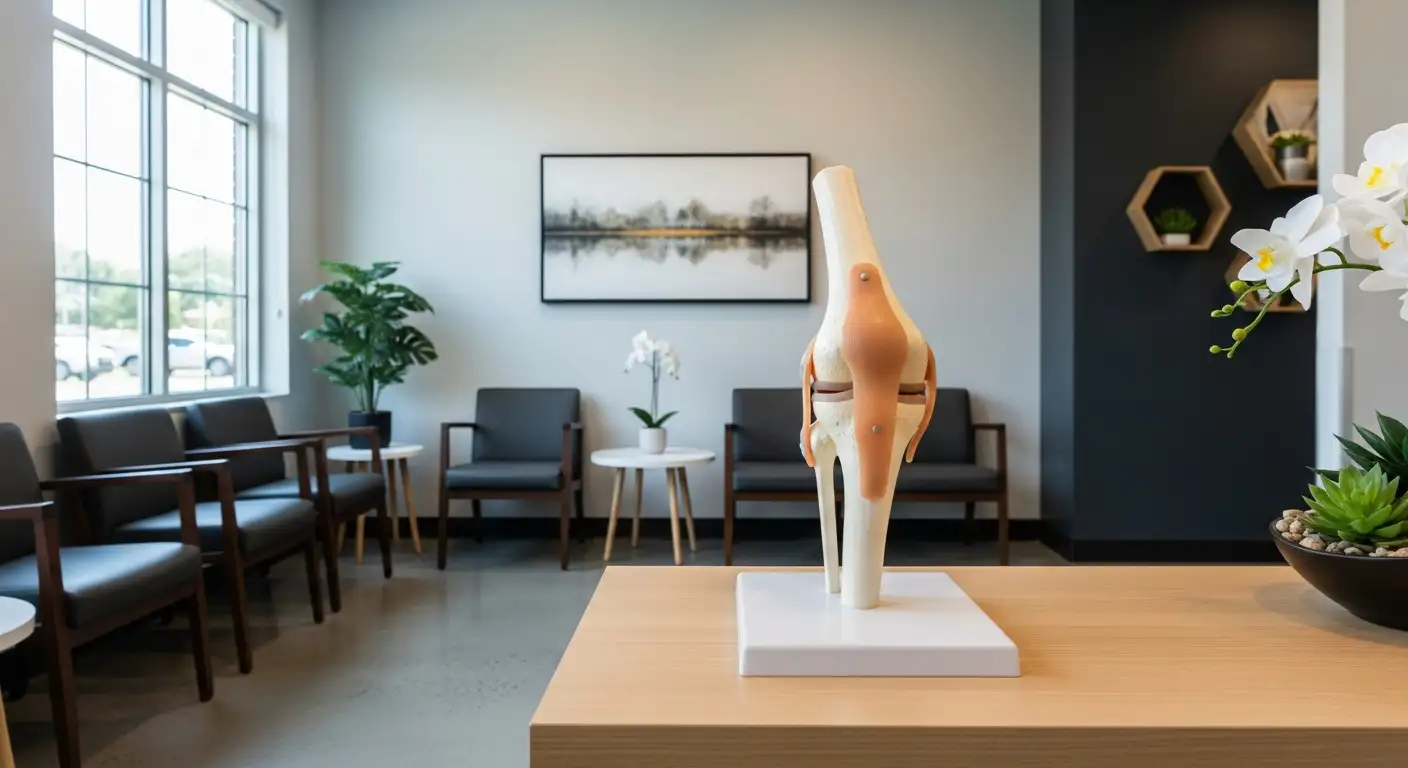Understanding Knee Pain
Before delving into the specifics of knee pain when going up and down stairs, it's essential to understand the basics of knee anatomy and the common symptoms of knee pain.

Anatomy of the Knee
The knee is a complex joint comprised of bones, tendons, ligaments, and cartilage. Its diverse composition makes it vulnerable to various types of injuries, which can contribute to pain during activities like climbing stairs.
The knee joint is primarily formed by three bones: the femur (thighbone), the tibia (shinbone), and the patella (kneecap). These bones are connected by several ligaments, which provide stability to the joint. Tendons connect the knee bones to the leg muscles that move the knee joint. Lastly, the surfaces where these three bones touch are covered with articular cartilage, a smooth substance that cushions the bones and enables them to move easily.

Any damage or injury to these components can lead to knee pain, making actions such as ascending or descending stairs challenging.
Common Symptoms of Knee Pain
Knee pain when going up and down stairs is a common issue, affecting approximately 25% of adults in the United States. This type of discomfort is particularly prevalent among older adults and is often a symptom of conditions like osteoarthritis or patellofemoral pain syndrome.
Common symptoms associated with knee pain when climbing or descending stairs include:
- A sharp or stabbing pain around the kneecap
- A dull, achy pain in the knee joint
- Increased pain when climbing or descending stairs
- Swelling or stiffness around the knee
- Difficulty fully extending or bending the knee
These symptoms can vary in severity depending on the underlying cause of the knee pain. For instance, patellofemoral pain syndrome, also known as runner's knee, typically causes pain around the kneecap when climbing stairs, squatting, running, or sitting for extended periods with the knees bent.
Understanding the anatomy of the knee and the common symptoms of knee pain is an important first step in managing knee pain when going up and down stairs. With this knowledge, individuals can better understand their symptoms, seek appropriate medical advice, and implement effective strategies to reduce their discomfort.
Causes of Knee Pain on Stairs
Experiencing knee pain when going up and down stairs can be a result of various conditions. It's important to understand the possible causes to take effective steps towards relief. The following are three common conditions that could be causing this discomfort: Patellofemoral Pain Syndrome, Osteoarthritis, and Ligament and Meniscus Injuries.
Patellofemoral Pain Syndrome
Patellofemoral pain syndrome (PFPS), also known as runner's knee, is one of the most common causes of knee pain when climbing stairs. PFPS occurs when the kneecap doesn't properly move with the knee joint, causing irritation and pain in the surrounding cartilage.
This condition is especially prevalent among individuals who are physically active and can cause pain not only when climbing stairs but also when squatting, running, or sitting for extended periods with the knees bent.
Osteoarthritis
Another common cause of knee pain when walking up stairs is osteoarthritis. This condition arises when the cartilage in the knee deteriorates, leading to the bones rubbing together and causing discomfort and pain. Osteoarthritis can be particularly painful when ascending stairs due to the increased pressure on the knee joint in this activity.
Interestingly, osteoarthritis is more common in women due to the higher likelihood of wearing high-heeled shoes. High heels can force the foot into an unnatural position, increasing pressure on the knees and causing significant joint damage.
Ligament and Meniscus Injuries
Injuries to the ligaments or meniscus in the knee can also cause pain when walking up or down stairs. Ligaments are tough bands of tissue that connect the bones within the knee joint, while the meniscus is a rubbery piece of cartilage that acts as a shock absorber between the thigh bone and shinbone.
Injuries to these structures can occur due to a variety of activities, such as sports or accidents. These injuries often result in pain, inflammation, and swelling, which can intensify when navigating stairs.
Understanding the possible causes of knee pain when climbing stairs is the first step in seeking effective treatment. Always consult with a healthcare professional for an accurate diagnosis and personalized treatment plan.
Impact of Lifestyle Factors
Lifestyle choices play a significant role in managing knee pain when going up and down stairs. Several factors like body weight, footwear, and physical activity can influence knee health.
Role of Body Weight
Maintaining a healthy weight is crucial in managing knee pain when climbing stairs. Extra weight puts additional pressure on the knees, which can aggravate pain. Weight loss, along with low-impact exercises like swimming and cycling, can help in alleviating knee pain during stair climbing, especially for older adults.
Influence of Footwear
The type of footwear one chooses can significantly impact knee health. Wearing flip flops and flats with no internal support can lead to collapsed arches, causing persistent foot pain and contributing to incorrect gait, which can strain the knees [6].
High heels that change the feet angle can misalign the body, putting continuous pressure on the kneecap and forcing the knees to work harder. Misalignment in shoes can cause knee strain and potential injuries.
Proper support in shoes is crucial to prevent instability in the ankles and knees. Athletic shoes with internal support, strong heel cups, and side posts are recommended, especially during physical activity like running or sports.
Effects of Physical Activity
Physical activity, especially the type that involves high impact on the knees, can exacerbate knee pain when going up and down stairs. Implementing modifications to reduce stress on the knees, such as avoiding high-impact activities, can help manage knee pain.
However, this doesn't mean one should avoid physical activity entirely. Low-impact exercises, such as swimming and cycling, can help strengthen the muscles around the knee, providing better support and reducing pain. Physical therapy can also be beneficial in managing knee pain and improving mobility.
By understanding the role of these lifestyle factors and making necessary adjustments, individuals dealing with knee pain can experience significant improvements in their daily life, including the ability to navigate stairs with less discomfort.
Managing Knee Pain on Stairs
Addressing knee pain when going up and down stairs involves a combination of lifestyle changes, physical therapy, and in severe cases, surgical intervention. Let's explore these aspects further.
Importance of Exercise
Incorporating specific exercises into your routine can play a pivotal role in managing knee pain during stair climbing. Exercises such as step-ups, step-downs, and eccentric single-leg squats can help strengthen the muscles around the knee and improve flexibility, thus reducing pain [7].
Maintaining a healthy weight through regular physical activity can also alleviate knee pain by reducing pressure on the knee joints. Low-impact exercises like swimming and cycling are particularly beneficial for older adults experiencing knee pain on stairs.
Role of Proper Footwear
The type of footwear you choose can have a significant impact on knee pain, especially when climbing stairs. Shoes that provide proper support can prevent instability in the ankles and knees, reducing strain and potential injuries. Athletic shoes with internal support, strong heel cups, and side posts are recommended, especially during physical activities like running or sports [6].
Conversely, flip flops, flats with no internal support, and high heels can lead to collapsed arches, incorrect gait, and continuous pressure on the kneecap, all contributing to knee strain and pain.
Considerations for Surgery
In more severe cases or when conservative measures are not effective, surgical options may be considered for addressing knee pain during stair climbing. Procedures such as knee arthroscopy, knee replacement, or physical therapy may be recommended.
A study conducted by the American Academy of Orthopaedic Surgeons found that 80% of people with knee pain when climbing stairs experienced significant improvement after a total knee replacement surgery.
However, it's critical to discuss all possible treatment options with a healthcare provider, as surgery should typically be considered as a last resort when other methods have not provided adequate relief.
In summary, managing knee pain when going up and down stairs involves a comprehensive approach that includes regular exercise, wearing appropriate footwear, and considering surgical options in severe cases. Always consult a healthcare professional for personalized advice and treatment plans.
Professional Help for Knee Pain
For individuals experiencing persistent knee pain when going up and down stairs, seeking professional help is a crucial step towards finding relief and improving mobility. This section details the importance of medical consultation, common diagnostic procedures, and the development of personalized treatment plans.
Importance of Medical Consultation
A medical consultation is essential for individuals experiencing knee pain when ascending or descending stairs. Persistent knee pain is often a symptom of underlying conditions such as osteoarthritis or patellofemoral pain syndrome. A healthcare professional can provide an accurate diagnosis and recommend a comprehensive treatment plan tailored to the individual's needs. Early consultation can help prevent the progression of knee issues and improve the quality of life [1].
Diagnostic Procedures
Diagnostic procedures for knee pain typically involve a physical examination to assess pain levels, range of motion, and signs of swelling or inflammation. The healthcare provider may also inquire about the patient's medical history, lifestyle factors, and the nature and frequency of the pain.
In some cases, imaging tests like X-rays, MRI, or CT scans may be necessary to visualize the structures of the knee and identify any abnormalities. These diagnostic tools can help determine the root cause of knee pain when going up and down stairs, enabling healthcare providers to develop a targeted treatment plan.
Personalized Treatment Plans
Treatment plans for addressing knee pain when climbing stairs are typically personalized based on the individual's diagnosis, pain severity, mobility, and lifestyle. These plans may involve various approaches such as physical therapy, medications, lifestyle modifications, and in certain cases, surgery.
Physical therapy exercises can strengthen the muscles around the knee, enhance stability, and reduce pain. Medications can help manage pain and inflammation. Lifestyle modifications like maintaining a healthy weight and wearing proper footwear can alleviate stress on the knee.
In more severe cases or when conservative measures are not effective, surgical options such as knee arthroscopy or knee replacement may be recommended to address knee pain when climbing stairs [8].
Remember, it's crucial to consult with a healthcare provider before starting any treatment plan for knee pain. They can provide guidance based on your specific needs and ensure that your treatment is both safe and effective.
References
[1]: https://www.hingehealth.com/resources/articles/pain-in-knee-when-climbing-stairs/
[2]: https://www.motionorthodocs.com/blog/why-you-may-have-knee-pain-when-walking-up-the-stairs/
[3]: https://phoenixrehabgroup.com/articles/knee-pain-treatment/knee-pain-when-climbing-stairs/
[4]: https://www.jonathanshultsmd.com/blog/how-your-shoes-impact-your-knee-pain
[5]: https://www.webmd.com/healthy-aging/features/knee-pain-aging
[6]: https://noyeskneeinstitute.com/8-ways-the-wrong-shoes-can-affect-your-knees/
[7]: https://theprehabguys.com/how-to-decrease-knee-pain-using-the-stairs/
[8]: https://www.healthline.com/health/pain-relief/knee-pain-stairs





